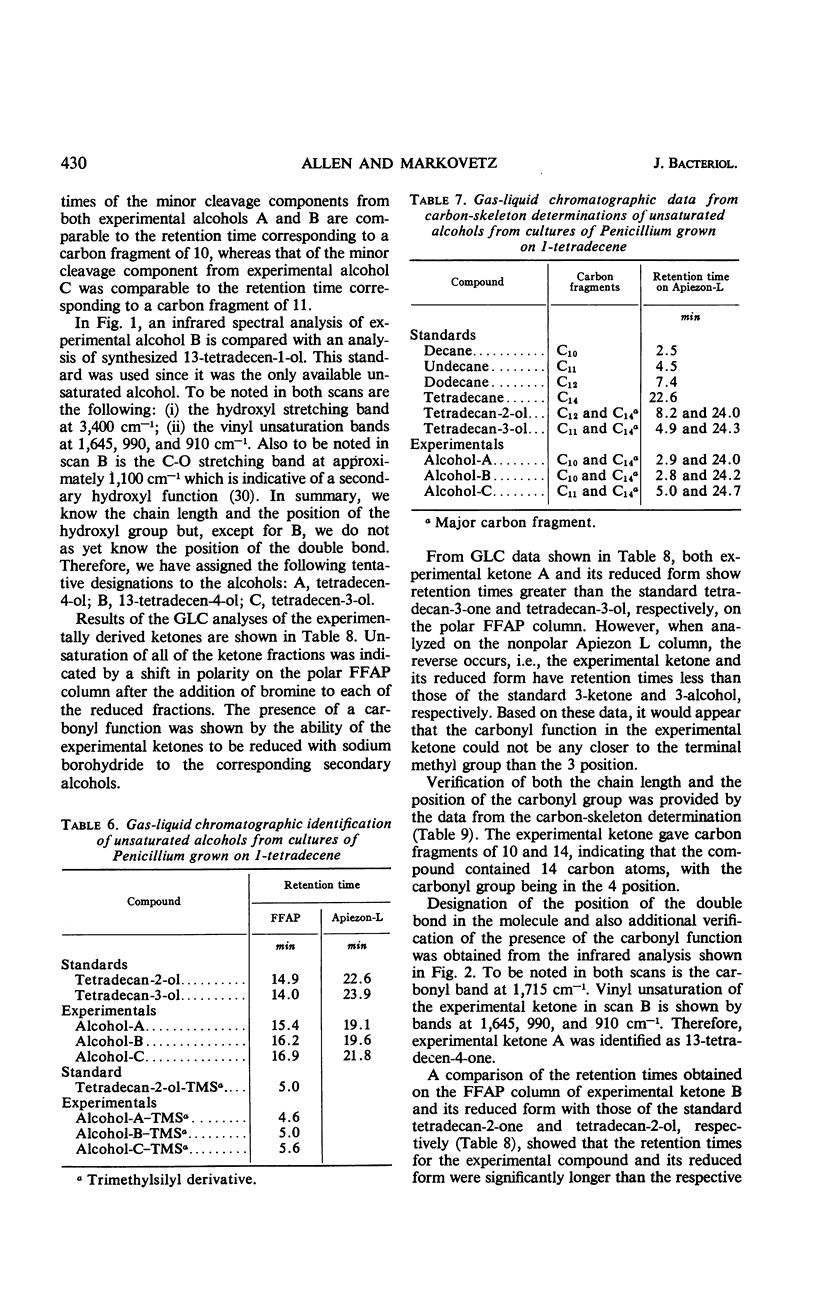Abstract
Cunninghamella blakesleeana (minus strain) and a Penicillium species were grown in a mineral-salts medium containing either n-tetradecane or 1-tetradecene as substrate, and ether extracts of the mycelial mats were analyzed for oxidation products. Extracts from Cunninghamella revealed tetradecanoic acid and 13-tetradecenoic acid from the oxidation of n-tetradecane and 1-tetradecene, respectively, thereby indicating that these hydrocarbons were subject to methyl group oxidation. In contrast to Cunninghamella, the Penicillium oxidized the two substrates by subterminal attacks on methylene rather than methyl groups. This was evidenced by tentative identifications of the following alcohols and ketones from oxidation of the hydrocarbons: tetradecan-2-ol, dodecan-1-ol, tetradecan-2-one, and tetradecan-4-one from n-tetradecane, and tetradecen-4-ol, 13-tetradecen-4-ol, tetradecen-3-ol, 13-tetradecen-4-one, and tetradecen-3-one from 1-tetradecene. A pathway for hydrocarbon oxidation is proposed for subterminal oxidation at the methylene alpha to the methyl group.
Full text
PDF








Selected References
These references are in PubMed. This may not be the complete list of references from this article.
- BAPTIST J. N., GHOLSON R. K., COON M. J. Hydrocarbon oxidation by a bacterial enzyme system. I. Products of octane oxidation. Biochim Biophys Acta. 1963 Jan 1;69:40–47. doi: 10.1016/0006-3002(63)91223-x. [DOI] [PubMed] [Google Scholar]
- FOSTER J. W. Hydrocarbons as substrates for microorganisms. Antonie Van Leeuwenhoek. 1962;28:241–274. doi: 10.1007/BF02538739. [DOI] [PubMed] [Google Scholar]
- Forney F. W., Markovetz A. J. An enzyme system for aliphatic methyl ketone oxidation. Biochem Biophys Res Commun. 1969 Sep 24;37(1):31–38. doi: 10.1016/0006-291x(69)90876-6. [DOI] [PubMed] [Google Scholar]
- Forney F. W., Markovetz A. J. Oxidative degradation of methyl ketones. II. Chemical pathway for degradation of 2-tridecanone by Pseudomonas multivorans and Pseudomonas aeruginosa. J Bacteriol. 1968 Oct;96(4):1055–1064. doi: 10.1128/jb.96.4.1055-1064.1968. [DOI] [PMC free article] [PubMed] [Google Scholar]
- Fredricks K. M. Products of the oxidation of n-decane by Pseudomonas aeruginosa and Mycobacterium rhodochrous. Antonie Van Leeuwenhoek. 1967;33(1):41–48. doi: 10.1007/BF02045532. [DOI] [PubMed] [Google Scholar]
- Hopkins S. J. Growth of Aspergillus versicolor on higher paraffins. Biochem J. 1932;26(1):133–142. doi: 10.1042/bj0260133. [DOI] [PMC free article] [PubMed] [Google Scholar]
- JAMES A. T., MARTIN A. J. Gas-liquid chromatography: the separation and identification of the methyl esters of saturated and unsaturated acids from formic acid to n-octadecanoic acid. Biochem J. 1956 May;63(1):144–152. doi: 10.1042/bj0630144. [DOI] [PMC free article] [PubMed] [Google Scholar]
- KATES M., KUSHNER D. J., JAMES A. T. The lipid composition of Bacillus cereus as influenced by the presence of alcohols in the culture medium. Can J Biochem Physiol. 1962 Jan;40:83–94. [PubMed] [Google Scholar]
- Klein D. A., Davis J. A., Casida L. E., Jr Oxidation of n-alkanes to ketones by an Arthrobacter species. Antonie Van Leeuwenhoek. 1968;34(4):495–503. doi: 10.1007/BF02046471. [DOI] [PubMed] [Google Scholar]
- Klein D. A., Henning F. A. Role of alcoholic intermediates in formation of isomeric ketones from n-hexadecane by a soil Arthrobacter. Appl Microbiol. 1969 May;17(5):676–681. doi: 10.1128/am.17.5.676-681.1969. [DOI] [PMC free article] [PubMed] [Google Scholar]
- Klug M. J., Markovetz A. J. Degradation of hydrocarbons by members of the genus Candida 3. Oxidative intermediates from 1-hexadecene and 1-heptadecene by Candida lipolytica. J Bacteriol. 1968 Oct;96(4):1115–1123. doi: 10.1128/jb.96.4.1115-1123.1968. [DOI] [PMC free article] [PubMed] [Google Scholar]
- Klug M. J., Markovetz A. J. Degradation of hydrocarbons by members of the genus Candida. II. Oxidation of n-alkanes and l-alkenes by Candida lipolytica. J Bacteriol. 1967 Jun;93(6):1847–1852. doi: 10.1128/jb.93.6.1847-1852.1967. [DOI] [PMC free article] [PubMed] [Google Scholar]
- LUKINS H. B., FOSTER J. W. METHYL KETONE METABOLISM IN HYDROCARBON-UTILIZING MYCOBACTERIA. J Bacteriol. 1963 May;85:1074–1087. doi: 10.1128/jb.85.5.1074-1087.1963. [DOI] [PMC free article] [PubMed] [Google Scholar]
- Lowery C. E., Jr, Foster J. W., Jurtshuk P. The growth of various filamentous fungi and yeasts on n-alkanes and ketones. I. Studies on substrate specificity. Arch Mikrobiol. 1968;60(3):246–254. doi: 10.1007/BF00413491. [DOI] [PubMed] [Google Scholar]
- MANN K. M., HANSON F. R., O'CONNELL P. W., ANDERSON H. V., BRUNNER M. P., KARNEMAAT J. N. Studies of the microbiological oxidation of steroids by Cunninghamella blakesleeana H-334. I. The effect of alcohols and phenol. Appl Microbiol. 1955 Jan;3(1):14–16. doi: 10.1128/am.3.1.14-16.1955. [DOI] [PMC free article] [PubMed] [Google Scholar]
- Markovetz A. J., Jr, Cazin J., Allen J. E. Assimilation of alkanes and alkenes by fungi. Appl Microbiol. 1968 Mar;16(3):487–489. doi: 10.1128/am.16.3.487-489.1968. [DOI] [PMC free article] [PubMed] [Google Scholar]
- Markovetz A. J., Klug M. J., Forney F. W. Oxidation of 1-tetradecene by Pseudomonas aeruginosa. J Bacteriol. 1967 Apr;93(4):1289–1293. doi: 10.1128/jb.93.4.1289-1293.1967. [DOI] [PMC free article] [PubMed] [Google Scholar]
- McKenna E. J., Kallio R. E. The biology of hydrocarbons. Annu Rev Microbiol. 1965;19:183–208. doi: 10.1146/annurev.mi.19.100165.001151. [DOI] [PubMed] [Google Scholar]
- Nyns E. J., Auquière J. P., Wiaux A. L. Taxonomic value of the property of fungi to assimilate hydrocarbons. Antonie Van Leeuwenhoek. 1968;34(4):441–457. doi: 10.1007/BF02046466. [DOI] [PubMed] [Google Scholar]
- STEWART J. E., KALLIO R. E., STEVENSON D. P., JONES A. C., SCHISSLER D. O. Bacterial hydrocarbon oxidation. I. Oxidation of n-hexadecane by a gram-negative coccus. J Bacteriol. 1959 Sep;78:441–448. doi: 10.1128/jb.78.3.441-448.1959. [DOI] [PMC free article] [PubMed] [Google Scholar]
- THIJSSE G. J., van der LINDEN A. Pathways of hydrocarbon dissimilation by a Pseudomonas as revealed by chloramphenicol. Antonie Van Leeuwenhoek. 1963;29:89–100. doi: 10.1007/BF02046042. [DOI] [PubMed] [Google Scholar]
- VAN DER LINDEN A. C. EPOXIDATION OF ALPHA-OLEFINS BY HEPTANE-GROWN PSEUDOMONAS CELLS. Biochim Biophys Acta. 1963 Sep 3;77:157–159. doi: 10.1016/0006-3002(63)90484-0. [DOI] [PubMed] [Google Scholar]
- van der Linden A. C., Thijsse G. J. The mechanisms of microbial oxidations of petroleum hydrocarbons. Adv Enzymol Relat Areas Mol Biol. 1965;27:469–546. doi: 10.1002/9780470122723.ch10. [DOI] [PubMed] [Google Scholar]


